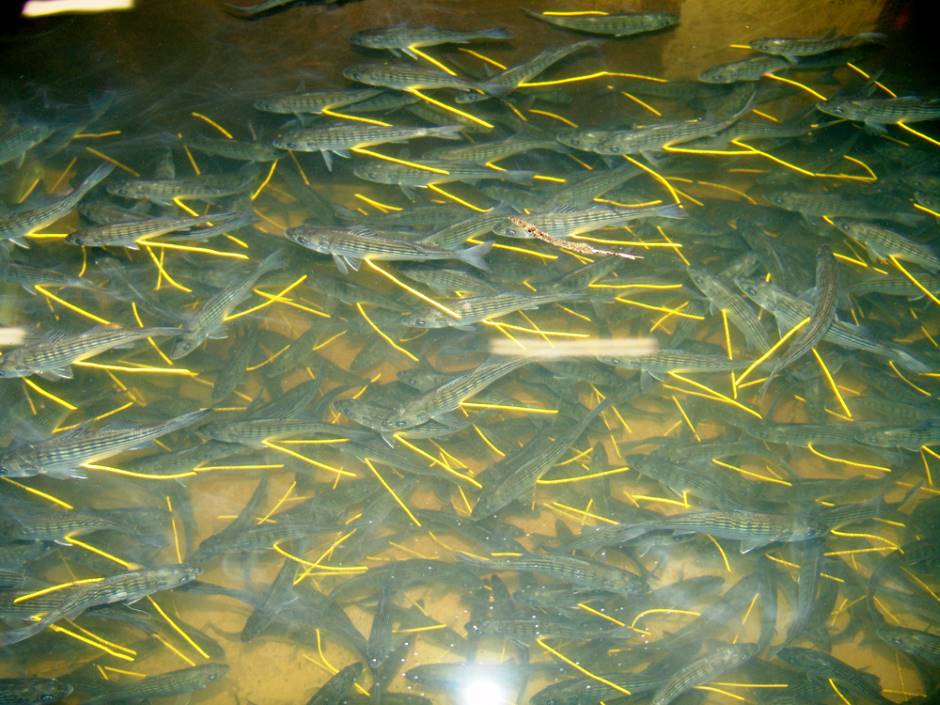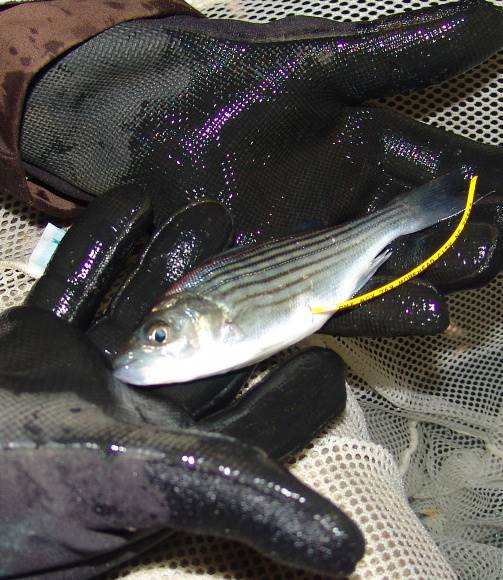Considerations for Fish Stocking
 Striped bass swimming in the hatchery with tags carrying contact information. (Credit: North Carolina Wildlife Resources Commission)
Striped bass swimming in the hatchery with tags carrying contact information. (Credit: North Carolina Wildlife Resources Commission)Many fisheries engage in fish stocking, and the strategies they use can significantly influence the effectiveness of these efforts. Stocking location and strategy, source fish location, species, and the age of the stocked fish can all affect the success of these efforts.
Why Stock Fish?
Resource managers and fisheries management teams stock fish for a multitude of reasons, ranging from conservation to research. In both cases, endangered or threatened species are often the focus of stocking programs. Stocking fish increases the total population size, hopefully leading to larger natural reproduction and population growth.
Stocking can also help offset some of the damages caused by invasive species. Since invasive species usually eat threatened/endangered species (either as fry or adults) or outcompete them in the ecosystem, the population boost can mean a larger pool of adult fish for reproduction in the following years.
Sometimes, fish are stocked in order to meet the demand of anglers. High-value fish that anglers travel many miles to catch equate to important funds for fisheries and state DNRs as anglers purchase local fishing licenses and any other expenses that help fund the upkeep of the ecosystem—which includes continuous stocking.
If the stocking efforts are being performed alongside research, the stocked fish may be tagged to track survival rates, predation, movement, catch rate, and other variables. Tracking all of the above can inform future stocking techniques as well as be used to better understand the target species’ behavior.
Things to Consider When Stocking
The age of the stocked fish is an important variable to consider. Typically, fingerlings of the target species are stocked when native fish would be reaching about the same size. However, stocked fish can range in size and age from fingerlings to yearlings—sometimes, retired broodstock are even stocked.
Stocking fingerlings is common since hatcheries sell young fish at a lower cost than yearlings and a significantly lower price than retired broodstock. The cost of rearing fingerlings is much cheaper as the fish are only under the hatchery’s care for a few months, while the yearlings take longer.
Yearlings are an investment for hatcheries as the larger fish require more food, larger enclosures, and simply more time from the staff. Similarly, retired broodstock are adult fish that the hatchery has used to reproduce the target species in a controlled environment. Typically, the facility keeps and cares for these fish for a number of years, so they’re significantly pricier than the yearlings.
Deciding on which to choose can depend on what challenges the native population is facing. If simply trying to meet fishing demands, fingerlings can be a cost-effective approach, though the fish may be smaller than preferred. Yearlings can be a good choice in terms of balancing size with cost. Broodstock tend to be quite large, so anglers enjoy catching them, though they can be expensive and tend to live only a few years after retirement.
From a restoration and conservation perspective, stocking larger fish could protect them from predation, as smaller fish tend to be more likely to be eaten. However, the price of yearlings may limit the number of fish stocked as managers have limited funds. Broodstock are also not a common choice for restoration/conservation initiatives because they are costly, don’t live for very long, and are expensive.

A young striped bass with an internal anchor tag (Credit: North Carolina Wildlife Resources Commission)
Fish Stocking Techniques
Stocking techniques depend on a variety of factors involving the fish and lake conditions—all of which can influence the survival rates of the fish.
For example, stocking fingerlings in deep water may lead the fish to be preyed on very soon after release, as most young fish stay in shallower water where they can hide more easily amongst vegetation. Additionally, stocking the fish in a hypoxic zone or an area with poor water quality can also harm the stocked fish and lead the weaker, younger fish to die soon after.
While the cost of broodstock makes it an uncommon choice for restoration, they are occasionally used in specific research initiatives. For example, North Carolina has built a thriving fishery in the Roanoke River and Albemarle Sound that draws thousands of anglers a year through comprehensive stocking programs.
The use of striper broodstock played a role in the growth of striped bass populations, and a 2014 study examined how they fared when stocked in other rivers, like the Tar-Pamlico and Neuse rivers, where the species continues to flounder.
Commonly referred to as “cross-stocking” or rearing a fish in one water body and then stocking it in another—the practice is a bit controversial. Some have theorized that stocked fish might not do as well in “non-natal” systems outside of their home range.
“The hypothesis would be that they would do the best in their natal system because that’s where they spend their juvenile life,” says Jody Callihan, lead author of the study. “They’re adapted to optimize growth in their natal system.”
However, results show that the Roanoke River fish were growing just as fast, or even slightly faster, in the Pamlico Sound tributaries. While the fish were also disappearing faster, Callihan attributes this to the system’s proximity to higher chances of marine predators.
Conclusion
Depending on the goal of the stocking program, the age and type of fish, and lake conditions, various stocking techniques may be used, and success levels will vary. It’s important for fishery managers to balance the cost with the benefits of stocking a specific fish and whether fingerling, yearling, or adult fish will be a better investment.



0 comments